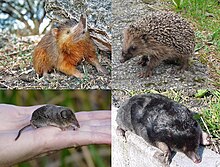യൂലിപോടൈഫ്ല
ദൃശ്യരൂപം
| Eulipotyphla Temporal range: Upper Cretaceous – Recent
| |
|---|---|

| |
| ശാസ്ത്രീയ വർഗ്ഗീകരണം | |
| കിങ്ഡം: | |
| Phylum: | |
| Class: | |
| Order: | Eulipotyphla
|
സസ്തനികളിലെ ഒരു നിരയാണ് യൂലിപോടൈഫ്ല (Eulipotyphla) ("ശരിക്കും തടിച്ചതും കണ്ണുകാണാത്തതും"[1])
ഇതിൽ ഇത്തിൾപ്പന്നികളും ജിമ്ന്യൂറുകളും സോളിനോഡോണുകളും ഡെസ്മാനുകളും, മോളുകളും നച്ചെലിയെപ്പോലുള്ള മോളുകളും നച്ചെലികളും ഉൾപ്പെടുന്നു.[2][3][4]
വർഗ്ഗീകരണം
[തിരുത്തുക]- Order Eulipotyphla (= 'Lipotyphla' − Afrosoricida = 'Erinaceomorpha' + 'Soricomorpha')
- Family Erinaceidae
- Family Soricidae
- Subfamily Crocidurinae: white-toothed shrews
- Subfamily Soricinae: red-toothed shrews
- Subfamily Myosoricinae: African white-toothed shrews
- Family Talpidae
- Subfamily Desmaninae: desmans
- Subfamily Talpinae: moles
- Subfamily Uropsilinae: shrew-like moles
- Family Solenodontidae: solenodons
- † Family Nesophontidae: extinct West Indian shrews
- † Family Amphilemuridae
Family-level cladogram of extant eulipotyphlan relationships, following Roca et al. and Brace et al.:[3][5]
| Eulipotyphla |
| ||||||||||||||||||||||||
അവലംബം
[തിരുത്തുക]- ↑ Hassan, Mo (2009-10-11). "British Wildlife: N". The Disillusioned Taxonomist blog. Retrieved 2015-11-26.
{{cite web}}: Italic or bold markup not allowed in:|website=(help) - ↑ Douady, C. J.; Chatelier, P. I.; Madsen, O.; de Jong, W. W.; Catzeflis, F.; Springer, M. S.; Stanhope, M. J. (October 2002). "Molecular phylogenetic evidence confirming the Eulipotyphla concept and in support of hedgehogs as the sister group to shrews". Molecular Phylogenetics and Evolution. 25 (1): 200–209. doi:10.1016/S1055-7903(02)00232-4.
- ↑ 3.0 3.1 Roca, A. L.; Bar-Gal, G. K.; Eizirik, E.; Helgen, K. M.; Maria, R.; Springer, M. S.; O'Brien, S. J.; Murphy, W. J. (2004-06-10). "Mesozoic origin for West Indian insectivores". Nature. 429 (6992): 649–651. Bibcode:2004Natur.429..649R. doi:10.1038/nature02597. PMID 15190349.
- ↑ Bininda-Emonds, O. R. P.; Cardillo, M.; Jones, K. E.; MacPhee, R. D. E.; Beck, R. M. D.; Grenyer, R.; Price, S. A.; Vos, R. A.; Gittleman, J. L.; Purvis, A. (2007-03-29). "The delayed rise of present-day mammals". Nature. 446 (7135): 507–512. doi:10.1038/nature05634. PMID 17392779.
- ↑ Brace, Selina; Thomas, Jessica A.; Dalén, Love; Burger, Joachim; MacPhee, Ross D.E.; Barnes, Ian; Turvey, Samuel T. (13 September 2016). "Evolutionary history of the Nesophontidae, the last unplaced Recent mammal family". Molecular Biology and Evolution (Epub ahead of print). 33: 3095–3103. doi:10.1093/molbev/msw186. PMID 27624716.
{{citation}}: Unknown parameter|lastauthoramp=ignored (|name-list-style=suggested) (help)
